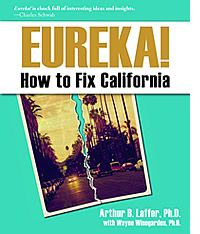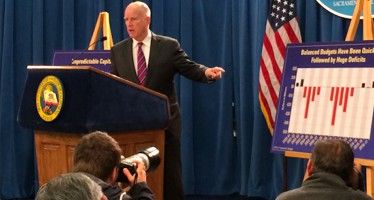Laffer flat tax would make California boom
By Brian Calle and Josephine Djuhana
It should come as no surprise that the economic growth rates and prosperity for states with excessive regulations and taxes are much lower when compared to states with fewer regulations and modest taxes. Incentives, such as low taxes and humble regulations, attract business and investment, which in turn spur economic benefits and job growth. It is not Republican or Democrat, liberal or conservative, “it’s just good economics,” as Arthur Laffer, noted economist and economic advisor to former President Ronald Reagan, likes to say.
California lawmakers ought to take note.
Laffer’s new book, “Eureka! How to Fix California,” was commissioned by the Pacific Research Institute, CalWatchDog.com’s parent think tank. The former California resident attempts to knock some sense into the political class in Sacramento, urging policy makers to focus on good economics instead of politics as usual. He wrote the book, he said, to create a blueprint for reforming California— to put the once Golden State back on a path of prosperity.
Laffer looked at various state economic data and found some significant disparities between states that instituted progressive income tax policies versus those that did not—particularly the gap in state growth between states with income taxes and states with none.
Eleven states introduced progressive income taxes within the past fifty years—Connecticut, New Jersey, Ohio, Rhode Island, Pennsylvania, Maine, Illinois, Nebraska, Michigan, Indiana and West Virginia. And of the 11, all states declined as a share of the U.S. economy. Michigan’s economy, for example, was at 5.08 percent of the US economy in 2005; that percentage slid to 2.64 percent in 2010. Like Michigan, Ohio’s wealth diminished as a result of similarly poor economic policies, Laffer argues. “The only things that still look nice in Ohio are the public government buildings,” remarked Dr. Laffer, during a recent stop on his book tour in Orange County.
Laffer also explores migration patters between states with varying tax rates; comparing “right-to-work” states—states where employees retain the right to decide whether or not to join or financially support a union—and “forced unionism” states—where an individual must pay union fees as a condition of employment and has forced union representation.
Right-to-work growth
In right-to-work states, Laffer found more economic growth, while “forced union” states trended the opposite direction.
The 22 right-to-work states experienced a 52.83 percent jump in gross state product; on the other hand, the 28 “union-shop” states had a 41.72 percent gross state product growth, less than the 46.61 percent US average.
“Right-to-work” states also trumped their forced-union counterparts in personal income growth, payroll employment growth, population growth and net domestic in-migration. Part of the reason that the growth gap is so large is that employers have a tendency to move away from forced-union states, not just to scale back wages and salaries, but also to avoid intrusive union rules, lawsuits, work stoppage threats and more.
Laffer’s proposal to reform California’s tax system should come as no surprise for those who have followed his work. He calls for a flat tax for the state of California; one simple tax on net business sales, and another on personal unadjusted income. His proposal does call for keeping “sin taxes” on the books, those taxes on cigarettes, etc., that are more meant to alter behavior than to raise revenues. Those concerned with the role of government in legislating personal decisions might argue that such sin taxes ought to be ousted as well.
California’s current tax system causes much unsettling volatility in state tax income year-to-year by making budgeting at the state level often incoherent. For example, in 2001, income from capital gains taxes (and other onetime revenues) made up a quarter of state tax revenue, according to Laffer.
And California has so many taxes (Laffer stopped counting after he studied 162 of them) that the tax code is overwhelmingly and unnecessarily complex, hence Laffer’s push to simplify it.
Looking at Sacramento today, though, there appears to be no political will in the legislature or with Gov. Jerry Brown to reform the tax code and especially institute a flat tax. Laffer dismisses that, noting that, when Brown ran for president in 1992, Brown proposed a national flat tax, making it part of his platform in the Democratic primary. “He was the first prominent presidential candidate to ever propose a national flat tax,” Laffer said. Optimistically, Laffer argues that, given the right situation, Brown could be amenable. We shall see. Brown, this time around, seems more beholden to public employee unions than during his previous stint as governor.
“Political partisanship is ruining the politics of our country,” Laffer concludes. Fixing California requires a nonpartisan effort to eliminate excessive taxes and regulations, and to create a business-friendly environment that encourages economic activity. Laffer’s blueprint, in short, challenges California politicians to put partisanship aside and embrace simple economics.
Related Articles
Attack of the artificial crises
March 25, 2013 By Steven Greenhut SACRAMENTO — Not many of my friends or neighbors are sitting on pins and needles,
Restored Gann Limit Would Balance Budget
MARCH 25, 2011 By JOHN SEILER The problem with Calfornia’s $25 billion budget deficit is that state spending gushed upward
Gov. Brown: No new spending
Gov. Jerry Brown on Friday repeatedly warned against new spending programs as he introduced his revised budget, heeding advice from Moody’s and




